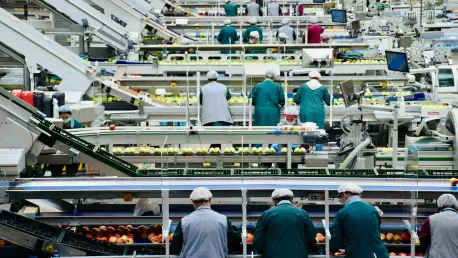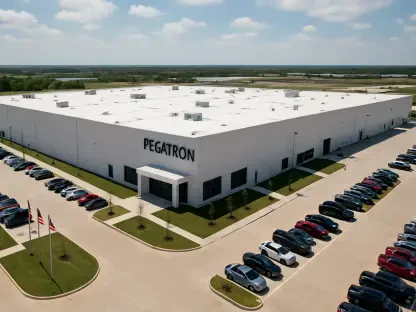The UK’s e-commerce boom is an unmistakable force driving faster delivery expectations while facing significant labor shortages. This has led to a remarkable surge in the adoption of warehouse automation technologies. As advancements make automated systems more accessible and adaptable, the UK is now competing to lead Europe’s warehouse automation market. However, the success of these systems hinges on foundational elements, specifically the quality and design of the racking that supports these automated operations.
The Role of Racking in Automation
Efficient and reliable racking systems are essential for the smooth operation of automated warehouses, particularly for maintaining the flow and accuracy of order picking.
Essential Racking Components
The racking system forms the backbone of an automated warehouse by ensuring that logistics processes are streamlined and efficient. Properly designed racking not only enhances the performance of automated systems but also minimizes maintenance needs and reduces potential downtime. Consequently, the selection and thorough assessment of racking constitute critical phases in the automation setup.
Certain structural components, such as uprights and beams, play an indispensable role in the racking system. These elements must be made with high manufacturing tolerances and installed correctly to ensure smooth, uninterrupted operation. Safety is another paramount concern — properly manufactured and installed racking systems prevent mishaps and ensure a secure working environment. Another notable recommendation for automated warehouse settings is the use of bolted frame components. This design choice allows easy substitution in cases where parts become damaged, thereby offering practical solutions for maintaining integrity and longevity.
Quality and Manufacturing
Evaluating core components of racking systems should be done with meticulous attention to detail. As part of this assessment, high tolerances must be maintained in both the manufacturing and installation processes. These standards ensure that the system operates smoothly and safely, without interruptions. Bolted frame components are particularly favored for their ease of replacement.
Moreover, a variety of upright sizes and material thicknesses are available to accommodate specific warehouse needs. These include high bay loads and tall frame heights for warehouses dealing with substantial storage requirements. Customized solutions, tailor-made for particular operational demands, are indispensable in crafting an efficient and reliable automated warehouse system.
Ensuring Racking Durability
Durability is a cornerstone for ensuring the long-term performance of racking systems in automated warehouses. Without durable materials, systems face increased maintenance and potential breakdowns.
Materials and Treatments
Quality materials equipped to handle daily operational stress significantly enhance the longevity of racking systems. Treatments like galvanizing and epoxy coating are often employed to bolster these materials against corrosion. These coatings provide high resistance to wear and environmental factors, ensuring that racking remains reliable over extended service intervals.
These treatments contribute to maintaining the structural integrity and functionality of racking components over time. This minimizes the frequency of replacements and repairs required, thereby reducing maintenance costs. Automation projects in warehouses demand long-lasting durability from every component, and robust racking systems play a pivotal role in achieving operational excellence.
System Integrity
System integrity starts with stable anchoring, ensuring the racking system is firmly rooted to the warehouse floor. Features like pallet support bars then add an extra layer of strength and durability to the overall system. These foundational elements are crucial for optimizing performance, as they contribute to the resilience and reliability of the entire automated warehouse.
Proper anchoring and support mechanisms mitigate risks associated with operational stresses and high loads. This ensures the automated systems operate efficiently and without interruption. When the integrity of the racking system is maintained, the overall reliability and effectiveness of the warehouse’s automated processes are significantly enhanced.
Compatibility and Integration
Smooth integration between various warehouse components is essential for the effective functioning of an automated system.
Seamless Integration
Compatibility between racking and storage containers is vital for avoiding disruptions in material flow. Ensuring that bins or containers fit properly within the racking system eliminates compatibility issues that could hamper operations. Suppliers who offer integrated solutions that encompass both racking and containers facilitate seamless interaction between storage components, thereby streamlining warehouse operations.
When bins roll improperly or do not fit correctly within the racking, it can lead to reduced storage density and operational inefficiencies. Specialized bins and trays designed for automated systems ensure smooth and efficient material handling. Their compatibility with the racking system fosters an integrated and cohesive automated process.
Optimal Container Design
Containers designed specifically for automated systems, like BITO’s XL series stacker containers and KLT small parts containers, are engineered to maximize storage density and ensure compatibility with racking. These custom solutions are tailored to streamline the automation process, enhancing the overall efficiency of warehouse operations.
Such containers facilitate optimal use of space and improve order fulfillment processes. By focusing on detailed design elements that harmonize with racking systems, manufacturers ensure their containers are robust, reliable, and an integral part of automated warehouse systems. This compatibility ultimately contributes to a more efficient and effective automated environment.
Supplier Expertise and Support
Selecting suppliers with proven expertise and reliable support services is crucial for the successful implementation and ongoing maintenance of automated warehouse systems.
Partner Collaboration
Suppliers with experience collaborating with systems integrators and other equipment providers, such as mezzanine floor and forklift truck companies, play a pivotal role in ensuring comprehensive integration. Effective partnerships are essential for harmonizing various elements of warehouse automation to create a cohesive system.
Collaborative efforts between suppliers and integrators foster practical and seamless solutions that address specific warehouse needs. Evaluations through reference site visits and consultations in showrooms can provide valuable insights into the practical applications and benefits of a supplier’s products. This thorough vetting process ensures that the chosen solutions fulfill operational requirements and perform reliably.
Ongoing Support
The e-commerce explosion in the UK has notably fueled expectations for quicker deliveries, all while battling considerable labor shortages. This scenario has significantly driven up the adoption of warehouse automation technologies. With technological advancements making automated systems more user-friendly and versatile, the UK is eager to establish itself as a leader in Europe’s warehouse automation sector. However, the triumphant implementation of these automated systems largely depends on some key foundational elements. One of the most critical among these is the quality and design of the racking systems that support automated operations. These essential components ensure that automation runs smoothly and efficiently, underlining that advanced technology alone is not enough without the proper infrastructure. Proper racking is crucial for the success and effectiveness of any warehouse automation initiative. Therefore, while automation is transforming warehouses, the foundational aspects like durable and well-designed racking systems remain indispensable.









